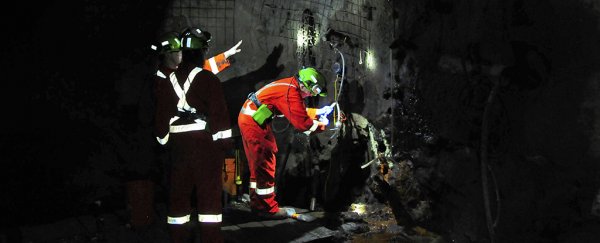Amongst all of Earth's abundant life, microorganisms have proven time and time again that they can live just about anywhere. Now, we have more evidence to add to the pile: living microbes have been found some 2.4 kilometres (1.5 miles) below the surface in a Canadian mine, a long way away from sunlight and clean air.
Researchers think that it's the presence of sulphates in the ancient underground water that's keeping these microscopic life forms alive; they're 'breathing' the sulphates to survive, rather than relying on oxygen.
The cave water itself is actually one of the oldest known pools of water on Earth, cut off from the surface of the planet for millions of years.
Finding life down at these depths would have been considered impossible until quite recently, due to the lack of the chemical ingredients that normally support living things.
"Even in the modern scientific era, the planet's biosphere was thought of as a thin veneer on or near the surface of the planet, with life primarily dependent on photosynthesis to thrive," write the researchers in their paper.
That hypothesis has been changing, though. Scientists took samples taken from deep inside the mine, and after testing that the prehistoric water had not been contaminated with water from mining operations closer to the surface, looked for signs of metabolic activity.
Having added food sources to incubated cells taken from the samples, the team found that the food was indeed being processed.
The results don't tell us exactly what the microbes are, but it does show that microbes – specifically sulphate reducers – are active, forging a living from the chemical reactions between water and rock deep below the surface.
"It's great to be able to see that they're there," geologist Barbara Sherwood Lollar, from the University of Toronto in Canada, told Catherine Offord at The Scientist.
"We were confident that they likely were, but it's a very long journey from that to a series of hard lines of evidence that actually supports it."
It backs up previous work from the same researchers that had found evidence of microbes living in this water – rich in hydrogen and sulphates – in the past. Now we know that the cycle of life is continuing.
While bacteria living deep inside mines might not have much of an impact on your day-to-day life, it expands our understanding of what life is, and how it can survive even in the harshest of environments.
That in turn informs everything from our search for life outside the Solar System, to investigating subterranean biospheres here on Earth. What's happening in Kidd Creek Mine in Canada might be happening elsewhere too.
And there could well be more to come, in terms of identifying both active and inactive microbes in this underground environment, something which is beyond the scope of this latest study.
"This paper is groundbreaking, so to speak," microbial ecologist John Spear from the Colorado School of Mines, who wasn't involved in the work, told The Scientist.
"They were able to get an idea of the amount of native microbial biomass… and they were able to confirm that the waters that the microbes are living in are host waters – they're not contaminated or impacted by water coming from the surface."
The research has been published in the Geomicrobiology Journal.
